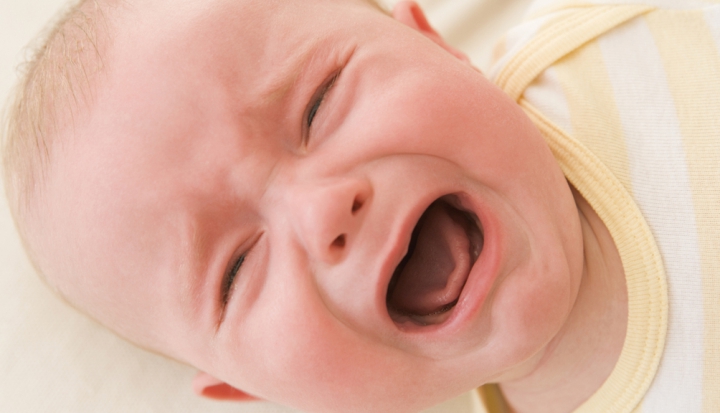Everyone can use a good cry now and then, especially children in church. Let’s make sure they have a place to let it out.
Sounding Board is one person’s take on a many-sided subject and does not necessarily reflect the opinions of U.S. Catholic, its editors, or the Claretians.
On a scale of one to 10, my kid goes to 11. At age 4, he’s high energy, high intelligence, and often highly challenging. I love everything about my little wild man until Sunday morning comes and we’re at Mass and everyone’s staring at me like I brought an ape into the room.
My husband and I are acutely aware of our little ape’s shenanigans. We shush. We chide. We whisper heatedly into his ear. We take him to the restroom and talk to him about appropriate church behavior. We point out better-behaved children. We explain the mystery of the Mass. We offer treats and books. We threaten. We occasionally literally cover his mouth with our hands.
But none of these measures works for long because our son is little, and little people aren’t that great at being quiet. While I believe children are inherently spiritual, this doesn’t mean they have the capacity to understand the sacred nature of transubstantiation and how maybe that particular point in the Mass is not a super great time to complain loudly about how itchy their butt is.
For us, the cry room is a necessity because children are a work in progress. We need a space to turn our little ape into a Mass-trained child, an overhaul of such proportions that removal from the staid silence of the pews is often required. With all these distractions to the actual Mass, the question remains: Do cry rooms really serve parishioners? The answer is yes.
I understand the ideal. My husband and son and I are working on it, but the reality is that taking children to Mass is stressful. In a perfect world, children of every age and activity level would sit in a pew alongside the rest of the congregation. And in a perfect world, the 60-something woman in front of me at Mass would not keep turning around to glare at me with that face that says, “My children were so much better behaved than yours when they were young.” Also in a perfect world, my son would not wonder loudly why Father is bald and why his robe is green this week and why Jesus is naked and why Jesus has that “yucky owie on his belly.”
To my mind, all of my son’s questions are valid and emblematic of a child who is paying attention to the Mass. Try telling that to the Stepford family of seven two rows behind me who are all sitting like beautiful, quiet portraits, except for the youngest, who keeps tugging at her mother’s sleeve and pointing at my wiggly, unruly child. OK, they are not a Stepford family. They are just expert parents who have it figured out, but I don’t, and I like to tell myself I’m not alone in this. So until my son hits whatever age it is when active little boys sit patiently while thumbing through their illustrated Baltimore Catechisms, I need the cry room.
I need a space to go to for a beat to explain the stations of the cross in a way that my son won’t find overly terrifying. I need a second to come up with a way to explain that yes, Jesus died, but he’s God so he is eternal and never really died. That’s a difficult conversation to whisper, especially when my fellow whisperer doesn’t really have whispering nailed down just yet. Compounding this is the fact that churches are built to carry voices, not contain them.
I’m constantly wondering how people have Mass-trained their children. A quick study of old-world architectural structures reveals the absence of any cry room plans. But even the oldest of churches had a quieting space, like a vestibule, where a child could be removed while a parent calmed her down, which brings to mind an image of the Blessed Mother holding a wiggly Jesus in the temple. Of course, Jesus probably never tried to get his mom to blow raspberries at him while gently slapping her puffed-up cheeks. He probably didn’t even play the classic infant game of “I drop it, you catch it.” So for Jesus there was no need, but what was available for less holy people like me and my son?
It wasn’t until the ’60s and ’70s that soundproof rooms started showing up. And while the cry room solved one set of problems for exasperated parents and distracted parishioners, it introduced a whole set of new ones. For instance, would cry room inhabitants still feel like full participants in the Mass? Will we be able to hear the priest, or will he sound like Charlie Brown’s teacher? Will there be other children running around like mad people providing just the sort of distraction my son is hoping for? Out of boredom and maybe hunger, will he eat the crushed Cheerios and dried-out raisins on the floor? Most importantly, will the somebody-just-changed-a-serious-diaper smell of the cry room distract me from the service above and beyond everything else that’s happening in there?
On top of these concerns is the reality that not everyone agrees on what the cry room should be used for. It is not difficult to point to a laundry list of cry room abuses. There are those who treat the space like a social hour instead of a holy hour, who let children play tag or any other number of noisy and athletic activities, who check e-mail, respond to texts, and let children play on their phones. Of course, there are also those doing the bare minimum of showing up who use the removed quality of the cry room to rest their eyes. With all of these rampant problems, it’s not difficult to understand the argument against cry rooms.
Perhaps the biggest argument against the cry room is that it detracts from the unity of the Mass. At a Mass at the Sistine Chapel in mid-January of this year, Pope Francis told his congregation: “Today the choir will sing, but the most beautiful choir of all is the choir of the infants who will make a noise. Some will cry because they are not comfortable or because they are hungry. If they are hungry, mothers, feed them, without thinking twice. Because they are the most important people here.”
My own priest echoes this sentiment. At our church, the median age of parishioners is 30. And if there is one thing that 30-year-old Catholics do well, it’s have children. Of the cacophony of small voices crying out during Mass, our priest says, “We consider our young parents and their children as fellow parishioners. I tell them we want them here in church with the kids. We do not get too many complaints. I think our older folks may be used to it—they are hopelessly outnumbered!”
I want to believe my priest and Pope Francis. I want to believe that my child, who really isn’t as poorly behaved as I’ve painted here, is very important to the congregation. I want to escape the purgatory of the cry room, but how can a parent who is sensitive to the prayer life of other people do this?
To those who are clamoring for the closing of cry rooms, I have this to say: I need it. Parents of all 2-year-olds who are more like little tyrants than people need it. Nursing moms need it. The real debate needs to focus on how the cry room should be used. A cry room should be a quieting space. Rather than a permanent storage facility for parents and their young children—a sort of purgatory for the unruly—the cry room should be a place to bring a child who is learning how to behave at Mass.
There are many ways to teach a child how to behave at Mass, and the success of this depends on both the child and the parent. A friend of mine uses the “no feet hit the ground” rule with babies, which conditions her children to understand that the cry room is not where they get to run free. Since her children behave better than mine at Mass, I can only assume this is a good rule.
But most parents have just one rule for teaching children how to behave at Mass: patience, patience, and more patience. When children are disruptive, take them out. When they quiet down, bring them back in. Do this on repeat no matter how little sleep you had last night or how colossal the fit being thrown. While it’s difficult to ignore the not-so-quiet clucks from disapproving parishioners who have done this so much better than I have, I know my job isn’t to make these people happy. My job is to give my son the gift of regular church practice. I wish this didn’t get in the way of other people’s church time. I really do. It weighs on me and frequently embarrasses me, but I’m doing my best.
Until I get it all figured out, I need the cry room. And I’m not alone. Parenting is an incredible gift and an even more incredible challenge. It’s the best job in the world and also the hardest. In trying to give our children the gift of the Mass, we need help. Parents of small children need the cry room if for no other reason than to have a little, tired cry ourselves before we return to Mass.
And the survey says…
1. I view the cry room as:
70% – A temporary necessity for some parents.
11% – An outmoded relic that should be done away with.
10% – A place where noisy, crying, or high energy children should usually be during Mass.
4% – A purgatory that every parent tries desperately to avoid.
5% – Other
2. I think that tensions in church surrounding children are caused primarily by:
38% – Parents who don’t have the sense to temporarily remove a very noisy child.
35% – Glaring adults who are intolerant of children behaving normally at Mass.
5% – Priests who supposedly want families to come to Mass but who do not tolerate children’s typical behavior.
3% – The presence of cry rooms, which suggests that children should be segregated rather than being part of the congregation.
19% – Other
Representative of “other”:
“It could be a combination of all of the above. My personal experience is the glaring adults who seem to forget when their own children were young and not perfect.”
3. Spending an entire Mass in the cry room is better than not going to church at all.
75% – Agree
15% – Disagree
10% – Other
Representative of “other”:
“Depends on the size and atmosphere in the cry room, and if it meets the spiritual needs of the family.”
4. Parents with small children should:
53% – Bring their children to church and move back and forth between the pews and cry room as necessary.
27% – Bring their children to Mass and make every effort to keep them in church the entire time.
8% – Bring their children to church but stay in the cry room or in the back of the church so as not to distract other worshippers.
3% – Come to Mass individually so that one parent can stay home with the children.
1% – Get a babysitter when it is time to go to church.
8% – Other
5. If I were designing a new church for my parish, I would personally vote in favor of having a cry room.
72% – Agree
20% – Disagree
8% – Other
This article appeared in the September 2014 issue of U.S. Catholic (Vol. 79, No. 9, pages 32-36).
Results are based on survey responses from 419 USCatholic.org visitors.
Image: ©Fotolia/Monkey Business













Add comment